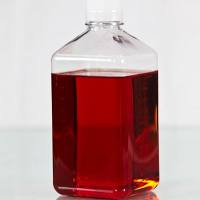Using ChemBank to Probe Chemical Biology
互联网
- Abstract
- Table of Contents
- Figures
- Literature Cited
Abstract
ChemBank (http://chembank.broad.harvard.edu/) is a public, Web?based informatics environment. ChemBank stores and makes freely available data derived from small molecules and small?molecule screens and has resources for relating and studying these data. Currently, ChemBank stores information on hundreds of thousands of small molecules and hundreds of biomedically relevant assays performed at the Broad Institute screening center. Web?based analysis tools are available within ChemBank to study the relationships between small molecules, cell measurements, and cell states. This unit demonstrates the use of ChemBank data to ask and answer questions relating to chemical biology and screening experiments contained within ChemBank. Curr. Protoc. Bioinform. 22:14.5.1?14.5.26. © 2008 by John Wiley & Sons, Inc.
Keywords: chemical biology; cheminformatics; data analysis; database; high?throughput screening; small molecule
Table of Contents
- Introduction
- Basic Protocol 1: Make a Hypothesis about the Potential Biological Activity of a Molecule
- Basic Protocol 2: Select Tested Compounds on Which to Pursue Additional Screening or Follow‐Up Chemistry
- Basic Protocol 3: Determine Which Small Molecules May Perturb Biological Pathways and Processes
- Basic Protocol 4: Dissect Small‐Molecule Structure Using Assay Profiles
- Basic Protocol 5: Identify Structurally Related Small Molecules with Known Biological Functions
- Basic Protocol 6: Download Data for Further Calculation Using External Applications
- Guidelines for Understanding Results
- Commentary
- Literature Cited
- Figures
- Tables
Materials
Figures
-
Figure 14.5.1 Screenshots of steps to search for a molecule by SMILES representation using ChemBank similarity search. (A ) ChemBank home page with search menus at far left. (B ) Illustration of SMILES input in the “search by user list” feature. (C ) ChemBank Molecule Display page associated with the search result from (B); the arrow in (C) shows how to search for structurally similar entries directly from the Molecule Display Web page. View Image -
Figure 14.5.2 Screenshot of portion of search results for molecules scoring as “hits” in an assay with the biological annotation of “anti‐bacterial.” View Image -
Figure 14.5.3 Screenshot of histogram of CompositeZ scores for the assay “DihydroorotateDehydrogenase: Calc(E1‐E2)(1021.0019).” Mock treatment measurements are depicted in red; compound‐treatment wells are depicted in blue. View Image -
Figure 14.5.4 Screenshot of scatterplot of Dimensionless Z‐score values (Seiler et al., ) for assay “1021.0019” in ChemBank. Mock‐treatment values are in red circles; compound‐treatment values are in blue squares; compound with ChemBankID “305289” highlighted in cyan. View Image -
Figure 14.5.5 Structure to be drawn in the JME Molecular Editor (Ertl and Jacob, ) for . View Image -
Figure 14.5.6 Screenshot of structure from Figure drawn within the structure editor interface in ChemBank. View Image -
Figure 14.5.7 Screenshot of .sdf export file output from a ChemBank download. (A ) Search results with the “export to SDF” function highlighted. (B ) Example of a single molecule record in .sdf output format, showing atomic coordinates and connection table. View Image -
Figure 14.5.8 Structure of ChemBankID 1000123 (A ) as shown on Molecule Display page and (B ) simplified structure created by using the DEL function in the JME Molecular Editor (Ertl and Jacob, ). View Image -
Figure 14.5.9 Screenshot of a multi‐assay heatmap from ChemBank. Assays from the “AspulivnoneUpregulation” project are depicted. Compound names and SMILES for the search results are depicted in the columns to the right of the heatmap view. View Image
Videos
Literature Cited
| Literature Cited | |
| Brooksbank, C., Cameron, G., and Thornton, J. 2005. The European Bioinformatics Institute's data resources: Towards systems biology. Nucl. Acids Res. 33:D46‐D53. | |
| Duffner, J.L., Clemons, P.A., and Koehler, A.N. 2007. A pipeline for ligand discovery using small‐molecule microarrays. Curr. Opin. Chem. Biol. 11:74‐82. | |
| Ertl, P. and Jacob, O. 1997. WWW‐based chemical information system. J. Mol. Struct. THEOCHEM 419:113‐120. | |
| Irwin, J.J. and Shoichet, B.K. 2005. ZINC: A free database of commercially available compounds for virtual screening. J. Chem. Inf. Model 45:177‐182. | |
| Seiler, K.P., George, G.A., Happ, M.P., Bodycombe, N.E., Carrinski, H.A., Norton, S., Brudz, S., Sullivan, J.P., Muhlich, J., Serrano, M., Ferraiolo, P., Tolliday, N.J., Schreiber, S.L., and Clemons, P.A. 2008. ChemBank: A small‐molecule screening and cheminformatics resource database. Nucl. Acids Res. 36:D351‐D359. | |
| Weininger, D.A. 1988. SMILES, a chemical language and information system 1: Introduction and encoding rules. J. Chem. Inf. Comput. Sci. 28:31‐36. | |
| Weininger, D.A. and Weininger, J.L. 1989. SMILES 2: Algorithm for generation of unique SMILES notation. J. Chem. Inf. Comput. Sci. 29:97‐101. | |
| Wheeler, D.L., Barrett, T., Benson, D.A., Bryant, S.H., Canese, K., Chetvernin, V., Church, D.M., DiCuccio, M., Edgar, R., Federhen, S., Geer, L.Y., Kapustin, Y., Khovayko, O., Landsman, D., Lipman, D.J., Madden, T.L., Maglott, D.R., Ostell, J., Miller, V., Pruitt, K.D., Schuler, G.D., Sequeira, E., Sherry, S.T., Sirotkin, K., Souvorov, A., Starchenko, G., Tatusov, R.L., Tatusova, T.A., Wagner, L., and Yaschenko, E. 2007. Database resources of the National Center for Biotechnology Information. Nucl. Acids Res. 35:D5‐D12. | |
| Wishart, D.S., Knox, C., Guo, A.C., Shrivastava, S., Hassanali, M., Stothard, P., Chang, Z., and Woolsey, J. 2006. DrugBank: A comprehensive resource for in silico drug discovery and exploration. Nucl. Acids Res. 34:D668‐D672. |








